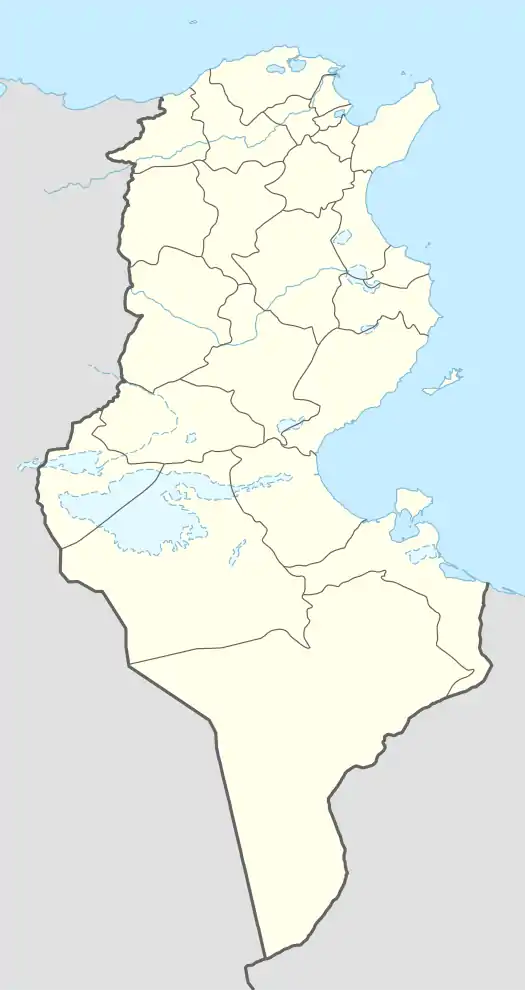Tebourba | |
|---|---|
.jpg.webp) Barrage Laaroussia of Tebourba | |
 Tebourba Location in Tunisia | |
| Coordinates: 36°50′N 9°50′E / 36.833°N 9.833°E | |
| Country | |
| Governorate | La Manouba Governorate |
| Population (2014) | |
| • Total | 27,648 |
| Time zone | UTC1 (CET) |
Tebourba (Tunisian Arabic: طبربة ⓘ) is a town in Tunisia, located about 20 miles (30 km) from the capital Tunis, former ancient city (Thuburbo Minus) and bishopric, now a Latin Catholic titular see.
Thuburbo Minus
Historically Thuburbo Minus ("Little Thuburbo") was a Roman settlement in Africa Proconsularis, located at present-day Tebourba, It was founded in the 1st century BC as a colony for veterans and was officially named Colonia VIII (Octavianorum) Thuburbi.[1] Despite the name it is believed to have been founded by Caesar for veterans of the Eighth and Thirteenth legions sometime after 46BC.[2] The second century Roman jurist Sextus Caecilius Africanus (d.c. 175) is believed to have come from Thuburbo Minus.[3] Thuburbo Minus is mentioned in the Antonine Itinerary, 44, and the Tabula Peutingeriana.
Situated on a hill, modern Tebourba occupied only a part of the ancient site, when it was rebuilt in the 15th century by the Andalusian Moors. The Roman amphitheatre, dated to the second century,[4] was still standing at the end of the 17th century, when it was destroyed to build a bridge. The nearby Thuburbo Maius ("Greater Thuburbo") is in ruins.
Raising sheep and the manufacture of woolen goods (vestis afra) seems to have been a significant part of the local economy.[5]
The diocese of Thuburbo Minus was a suffragan of Carthage. Traditionally, it was at Thuburbo Minus that the Christian martyrs Perpetua and Felicity with their companions were arrested. The two known bishops of this city were: Victor, present at the Conference of Carthage (411), where he had as his competitor the Donatist Maximinus; and Germanus, who signed (646) the letter of the bishops of the proconsulate to the Patriarch Paul II of Constantinople against the Monothelites.[6]
The remains of a basilica, the amphitheatre and some mosaics can still be seen.[1] The amphitheatre, which was dug partly into a hill, must have orignally measured 36 x 48 m.[7]
Titular see
Thuburbo Minus is included in the Catholic Church's list of titular bishoprics since the diocese was formally revived in the late 19th century.
It has had the following incumbents, of the lowest (episcopal) rank:[8]
- Jules-Etienne Gazaniol (1892.02.27 – 1896.12.03)
- François Gerboin, White Fathers (M. Afr.) (1897.01.28 – 1912.06.27)
- Étienne-Benoît Larue, M. Afr. (1913.01.28 – 1935.10.05)
- Xavier Ferdinand J. Thoyer, Jesuits (S.J.) (1936.12.23 – 1955.09.14) as last Apostolic Vicar of Fianarantsoa (Madagascar) (1936.12.23 – 1955.09.14), promoted first Bishop of Fianarantsoa (1955.09.14 – 1958.12.11), again promoted first Metropolitan Archbishop of Fianarantsoa (1958.12.11 – 1962.04.02); emeritate as Titular Archbishop of Odessus (1962.04.02 – death 1970.10.07)
- Cesare Marie Guerrero (1957.03.14 – 1961.03.28), as emeritate; previously Bishop of Lingayen (Philippines) (1929.02.22 – 1937.12.16), Titular Bishop of Limisa (1937.12.16 – 1949.05.14) & Auxiliary Bishop of Manila (Philippines) (1937.12.16 – 1949.05.14), Bishop of San Fernando (Philippines) (1949.05.14 – 1957.03.14)
- William John McNaughton (나길모 굴리엘모), Maryknoll Fathers (M.M.) (1961.06.06 – 1962.03.10)
- Nicholas Grimley, Society of African Missions (S.M.A.) (1962.05.07 – 1995.06.09)
- Antonio Pepito Palang, Divine Word Missionaries (S.V.D.) (2002.03.25 – ...), Apostolic Vicar of San Jose in Mindoro (Philippines)
World War II
Tebourba was the scene of The Battle of Tebourba Gap in the Tunisia Campaign of World War II, lasting from November 29 until December 4, 1942. The battle involved the 2nd Battalion of the Royal Hampshire Regiment of the British Army against the Axis Forces.
The Hampshires held the town for several days until it fell to the Germans on December 4.[9][10]
The battle is commemorated in the name of a road in Southampton, England called "Tebourba Way." There is a small war memorial on the roadside at the junction with Oakley Road. Tebourba Drive in Alverstoke, Gosport is also named after the battle, as is the Tebourba House apartment block in nearby Fareham. A row of 8 council houses on Outlands Lane in Curdridge, Hampshire are named Tebourba Way.
Notes
- 1 2 "Thuburbo Minus". Archiqoo. Retrieved September 27, 2023.
- ↑ Shaw, Brent D. (1981). "The Elder Pliny's African Geography". Historia: Zeitschrift für Alte Geschichte. 30 (4): 424–471. Retrieved September 27, 2023.
- ↑ "Caecilius Africanus, Sextus". Oxford Reference. Retrieved September 27, 2023.
- ↑ "A catalogue of North African amphitheatres". elibrary.net.
- ↑ Forbes, R.J. (1897). Studies in Ancient Technology, Volume IV. Brill. p. 14. ISBN 90-04-08307-3. Retrieved September 28, 2023.
- ↑ Herbermann, Charles, ed. (1913). . Catholic Encyclopedia. New York: Robert Appleton Company.
- ↑ Contencin, Alex. (1928). "L'Amphithéâtre de Thuburbo Minus". Le Bulletin de la Société Archéologique ds Sousse (in French) (19): 53. Retrieved September 28, 2023.
- ↑ Titular Episcopal See ofThuburbo minus.
- ↑ Atkinson, Rick (May 15, 2007). An Army at Dawn: The War in North Africa, 1942-1943. The Liberation Trilogy. Vol. 1. Macmillan Publishers (United States). p. 222. ISBN 9781429967631. Retrieved 2014-06-26.
- ↑ "The Battle of Tebourba Gap 29th November – 4th December 1942". Royal Hampshire Regiment. Retrieved September 27, 2023.
Sources and external links
- Attribution
![]() This article incorporates text from a publication now in the public domain: Herbermann, Charles, ed. (1913). "Thuburbo Minus". Catholic Encyclopedia. New York: Robert Appleton Company.
This article incorporates text from a publication now in the public domain: Herbermann, Charles, ed. (1913). "Thuburbo Minus". Catholic Encyclopedia. New York: Robert Appleton Company.